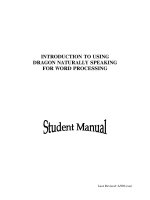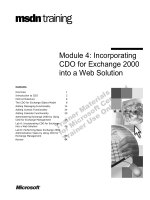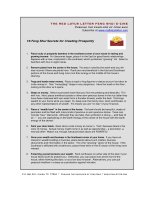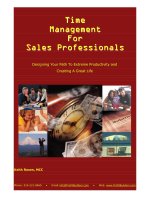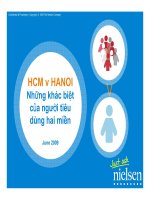Tài liệu Using Proven Sales Techniques for Selling WorkKeys as a Solution to Business doc
Bạn đang xem bản rút gọn của tài liệu. Xem và tải ngay bản đầy đủ của tài liệu tại đây (2.91 MB, 48 trang )
Using Proven Sales Techniques
for Selling WorkKeys as a
Solution to Business
Stacy A. Sacco, MBA
505-489-2311
New Mexico Networking Links
www.nmnetlinks.com
Presentation Outline
• Underlying Sales Principles
• Qualifying Prospects
• Active Listening Skills:
– Talk Benefits
– Mirroring Your Prospect
– Handling Objections
– Identifying Buying Signals
– Closing Techniques
– Creating a W.O.W. Moment
• Give It Back Better Than You Got it
• Break
• Role-Playing Scenarios
• Open Forum: Sales and Marketing Dialogue
2
Thinking Outside the Box
Using a pen or pencil, connect the dots with only four lines. Start at one dot and connect all of the dots
without living your pen or pencil from the paper. You may cross a dot more than once. Good luck!
3
4
5
6
7
R.O.I.
Your value is a factor of how much you help
increase bottom-line profits by either
increasing revenues or decreasing costs.
Profits = Revenues – Costs
8
MU/P Ratio
Marginal Utility
Value =
Price
(Driven by W.I.I.F.M.)
9
It’s Chess, Not Checkers
10
Think “Process”
Source: “The Deming Wheel,” W. Edwards Deming, 1950s
Consider using the PDCA Cycle to improve your performance.
11
A.I.D.A
Prospects go through 4 standard
steps on their way to a purchase.
• Awareness
• Interest
• Desire
• Action
12
The 10-Step Sales Process
1. Prospecting
2. Pre-approach
3. Approach
5. Presentation
7. Trial close
6. Uncover Objections
7. Meet Objections
8. Trial Close
9. Close
10. Follow-up and Service
13
The ABCs of Sales
Always
Be
Closing
14
The Sales Pipeline
# People you Meet
# Suspects
# Of Prospects
# Of Qualified Prospects
# Proposed
# Short List
# Closed Sales
15
Qualification Triangle
Decision Maker (DM)
Do they have the authority to
make the purchase?
Adequate Budget
Do they have $$$ to purchase
your products/services?
16
Needs Satisfaction
Do your products/services
meet their needs?
Steps to Making a Sale
A.I.D.A. vs. Sales Building Blocks
SALE!
Awareness
Interest
Desire
Action
4
3
2
1
I.D. Decision Maker
Does he/she have the authority to
purchase your services?
Establish Need
Does your hotel meet his/her needs?
I.D. Timeline
Are they ready to buy?
$ Budget
Does he/she have the money to
purchase your services?
17
Effective Communication
• Always have a goal in mind
• Meet the “person” before you meet their needs
• Ask questions to identify their pain and problems
• Always respond with benefits specific to them
• Be an “Interested Introvert,” not an “Interesting Extrovert”
• Listen actively: Repeat what they said and ask for their
feedback before moving on to the next issue
• Control the dialog by asking questions
• Conclude by summarizing and getting agreement on your
next steps, confirming there are no outstanding issues
• Convey a sense of urgency
• Thank them for their business
The key is to Listen more, Talk Less!
18
Look In the Mirror!
• Are you present?
• Are you smiling?
• Have you identified the real
problem?
• Have you ended on a positive
note, with solution to their
problem?
• Have you thanked them for
their time and business?
19
What do Customers Expect?
• To be treated in a fair and friendly
manner, graciously and
courteously
• That you want to help them
• To see you as the solution to their
problem, and not be seen as your
problem
• To be treated as mature adults,
not as children
• That you will be patient with them
if they are having trouble
explaining their concern
• That you will do what you say
you’re going to do!
Source: Life Skills Education
20
The Platinum Rule
• Golden Rule:
Treat others as you want to be treated
• Platinum Rule:
Treat others how they want to be treated
21
Talk Benefits
• Accessories
• Delivery
• Materials
• Options
• Price
• Quality
• Shape
• Size
• Weight
• Durable
• Easy to service / repair
• Easy to use
• Improved accuracy
• Lasts a long time
• Less maintenance
• More choices to meet
your individual needs
• Piece of mind
• Save money
Features Benefits
22
S.P.I.N Sales Method
Situation Questions (Used to collect facts):
- What business are you in? What’s your company’s mission?
Problem Questions (Identify dissatisfaction):
- What challenges are you facing?
Implication Questions (Probe for consequences):
- If you don’t solve your problem, how will that negatively effect your
business?
Needs / Payoff Questions (Based on core need):
- If you choose use product/service, how will it positively affect your
business?
Source: SPIN Selling, Neil Rackham, McGraw-Hill, 1988
23
What is Your U.S.P?
• A corporate mogul wines, dines, and falls in love with a charming hooker who
lives by her wits on the streets of Hollywood in the MY FAIR LADY for the ‘90s.
• A loveable ogre is ordered to rescue a princess from a fiery keep guarded by a
dragon in order to clear out his swamp of menacing fairytale creatures.
• An indomitable Southern belle loves and loses and loves again a slyly dashing
war profiteer as she struggles to protect her family and beloved plantation.
• A pig raised by sheepdogs, learns to herd sheep with a little help.
• A cynical weatherman is forced to continuously re-live the worst day of his life
until he learns to become a better person.
• A callous nightclub owner in a wartime way station has his world turned upside
down when his lost love returns.
• An impulsive but goodhearted young man sets out on a classic journey of good
and evil, to rescue a princess and the entire galaxy with the help of friendly
robots, a mysterious old hermit with incredible powers, a roguish mercenary
and his towering furry sidekick.
• A father-son underwater adventure featuring a boy clownfish stolen from his
coral reef home. His timid father must then search the ocean to find him.
24
Mirror Their Personality
• 16 Types:
- Carl Gustav Jung, 7/26/1875 - 6/6/1961
- Myers-Briggs Type Indicator, 1921
- Keirsey/Bates Temperament Sorter 1978
• 9 Types:
– Enneagram, Riso and Hudson, 1996
• 4 Types:
– Xerox Selling System
– DISC Four Quadrants, William M. Marston, 1928
• 2 Types
– Type A vs. B, Task vs. Social, Optimist vs. Pessimist
• Niche Markets:
– Cohorts Groups (PRIZM): The Nielsen Company
– Generational: Age Wave, Ken Dychtwald, PhD
• 7 Billion Types:
– Peppers & Rogers Group, www.1to1.com
25
